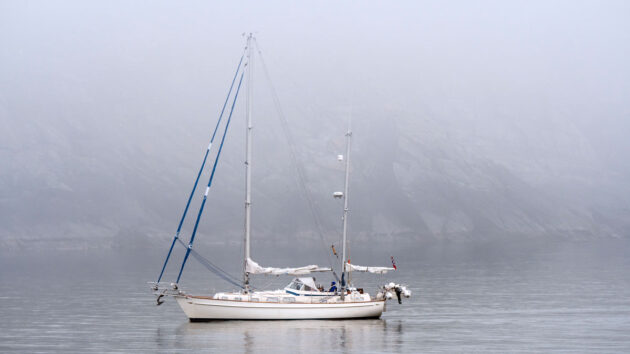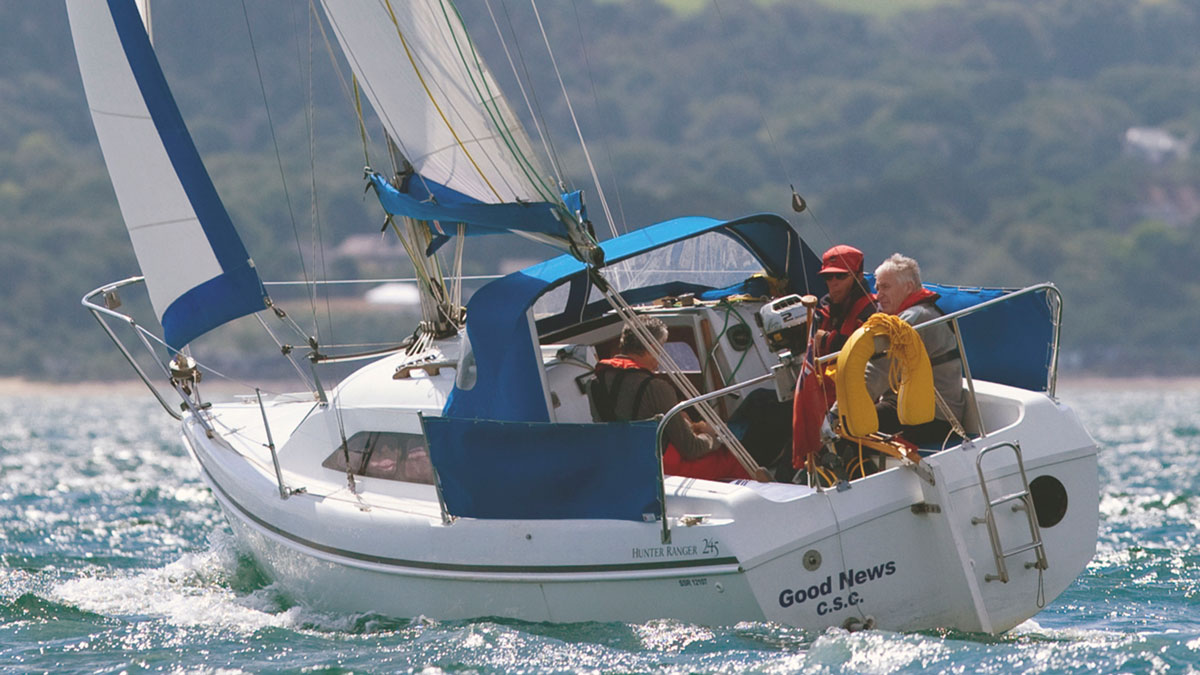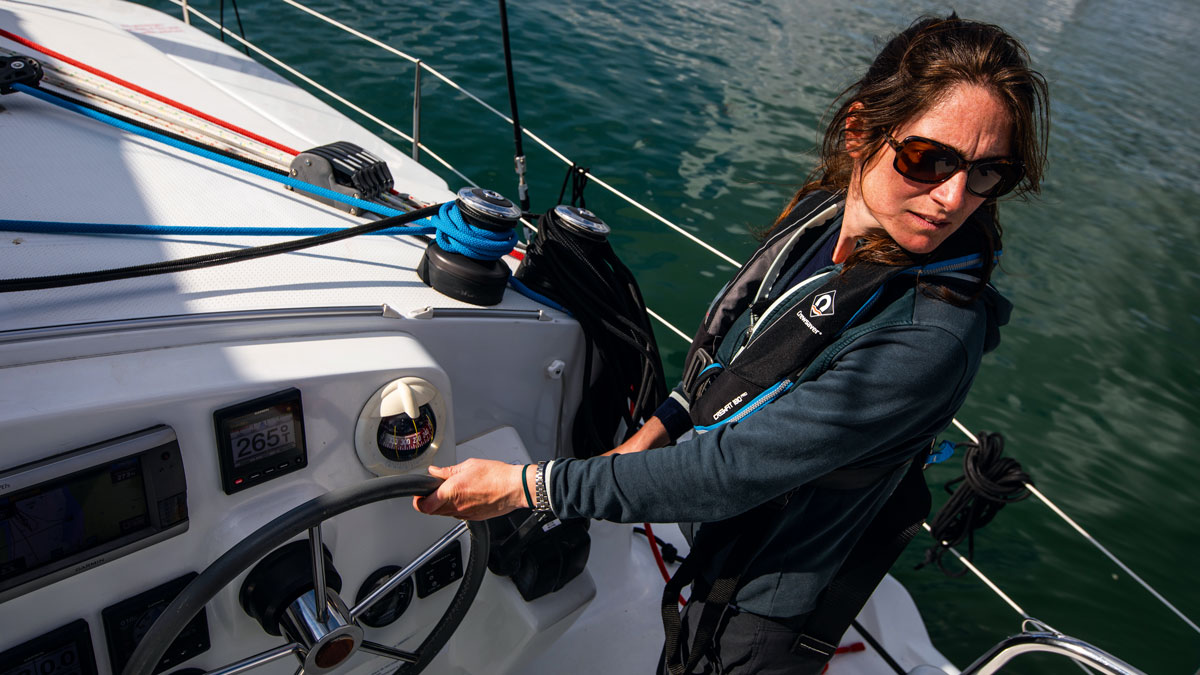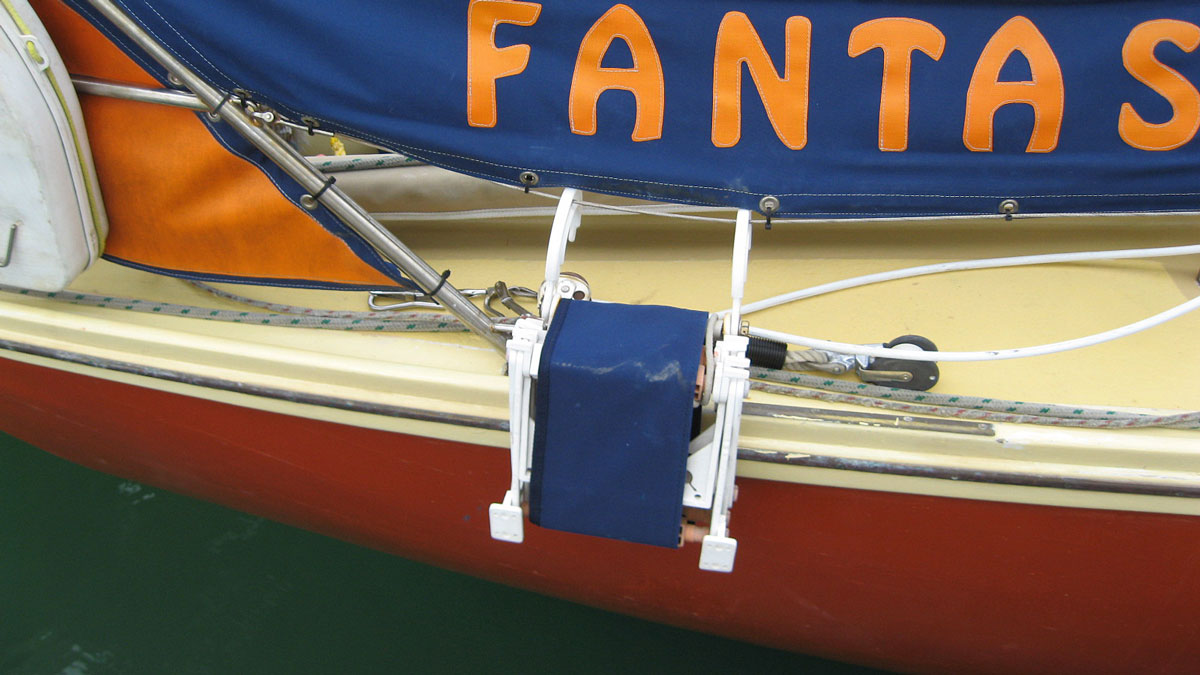Fog looms large as one of the things sailors most fear – but circumstances mean it often can’t be avoided. There’s no need to panic, however. Sticky Stapylton has advice for keeping calm and carrying on!
My first real experience of sailing in fog was during a crossing of the Bay of Biscay on our way to Casablanca via Gibraltar, writes Sticky Stapylton.
We had only one electronic aid, a good old Stowe echo sounder. Otherwise, I was relying on my sextant, a good watch, a compass, and a log.
The log was an old Walker, with a trailing spinner, which gave us speed and distance run.
I’d been warned that sharks take a fancy to spinners glinting in the sunlight, so brought three spares with me: this was a sensible move as we lost two of them over the next three years, sailing between Morocco, Madeira and the Mediterranean.
Our first stop after Plymouth was A Coruña in north-west Spain. I’d planned my arrival so that I would be able to pick up three long-range lights off the Spanish coast and get a good fix.
I drew semicircles of their ranges on the chart, and reckoned I should be able to get a fix on the lights about two hours before dawn.
We did, and I then shaped a course for the entrance to A Coruña harbour.

Many boats have a foghorn on board, but blowing it yourself can be hard work. Credit: Georgie Stocker
As we closed the coast the visibility dropped to about half a cable and we went into our fog drills.
The major problem was that the seabed shelves fairly rapidly from about 100m to nothing in a very short distance, so we would have to react quickly to any changes shown by the echo sounder.
By the time we closed the coast, it was daylight, and we were feeling our way in at about a knot of speed, the trailing log line almost vertical, when the lookout on the bow shouted ‘Rocks!’ and pointed, not ahead, but almost above his head!
Hard astern, with the echo sounder still showing a good depth, we reversed our course into deeper water, all of us gasping with relief.
A little while later, visibility clearing rapidly, we heard a large vessel’s foghorn and, motoring towards this sound, picked up her wake which luckily pointed directly to A Coruña’s harbour entrance.
My second major encounter sailing in fog was during a cross-Channel passage from Exmouth to L’Aber Wrac’h some 40 years or so ago.

A canister-operated foghorn is easier to use
It was the standard sea or advection fog caused by warm, moist air blowing over cold water and we experienced a real pea-souper, with visibility less than half a cable.
A lot of people think that a wind will blow this fog away, but not so: it will persist, and on this occasion, we had a blustery Force 5 from the south-west to contend with.
Again, these were pre-GPS days and I was relying on log, compass and echo sounder, with the addition of a magnificent radio direction finder (RDF), to help me find the entrance to the river.

If fog descends, get all of the crew on deck, making sure they are wearing lifejackets
Those of you of a certain age will recall the difficulty of finding the ‘null’ with RDF, and how you sometimes had to flip frequencies between transmitting stations quickly in order to get a three- (or more) point fix.
I was elated to locate the westerly cardinal, the Libenter, at the entrance to the river, and we felt our way gingerly up to the anchorage.
My third experience of sailing in fog was waking up on our mooring at the entrance to Millbrook Lake off the Tamar near Plymouth.
It was another pea-souper, which happened during a Yachtmaster preparation course.
Some of my fellow crew were surprised when I said we would have a quick breakfast, then get going to practise sailing skills, pilotage and a few other things as well.
Fog from the valleys
I reckoned we were seeing radiation fog, caused at times of high pressure when land fog drifts down valleys.
As this fog gets closer to the sea it meets the warmer water, rises and mixes with higher air.
With the sun heating this air from above, the fog quickly disperses. This is exactly what happened, so we weighed anchor and once in Plymouth Sound, we had excellent visibility.
My most recent encounter with fog was after a cross-Channel passage from Guernsey. We set off from St Peter Port, taking advantage of the flood tide to push us through the Alderney Race then spit us out into the Channel.
The wind was in the north-east quadrant so I assumed that with the high-pressure system, the fog would be more radiation than sea fog and therefore more likely to be in the river estuaries and dissipate out to sea. How wrong I was!

AIS is a godsend in fog
The fog, which we first encountered some 20 miles south of St Catherine’s light on the south of the Isle of Wight, was not only extensive, but really some of the thickest I have seen.
I do not think we had more than about 50m visibility, and sometimes less.
According to the weather experts, this very thick fog was caused by a lot of moisture from recent rains being trapped under a really large area of high pressure.
The fog had just not been able to disperse because of air holding it down.
I was on watch with two others when we first saw the fog: it had not been too long since the change of watch, so it was rather bad luck on the sleeping watch to be woken and asked to come on deck.
What to do when sailing in fog
If planning a voyage, what should you do if fog is forecast?
Firstly, do not go to sea. Often, however, the forecast sounds pretty benign and sailors take the risk and are then caught out. So it may be worthwhile just going through the drill to be followed when fog is encountered:
- All crew on deck. Lifejackets should be on and, in my view, harness strops hooked on. The danger of losing someone overboard in really thick fog is worse than somebody remaining hooked on in the event of a collision due to fog. Anyway, what happens if the collision is minor?
A large vessel should be heard as it approaches so the skipper could, if needs be, order crew to unhook. - Slow down, get a fix on the chart and review the navigational plan. A serious decision needs to be made if you are near shipping lanes. If close to the Traffic Separation Scheme (TSS), consider remaining in the separation zone between two lanes. Rule 10 of the Collision Regulations states: ‘a vessel shall, so far as practicable, keep clear of a separation line or separation zone’. If possible, head for shallow water, and if needs be, anchor. If close to a harbour entrance, and you have to go in, plan your pilotage to keep clear of the main channels.
- Post lookouts at the bow, port and starboard, and in the stern, if you have enough crew. Give each member an arc to observe and listen. Change everyone around every 10 minutes or so to keep them alert.
- If under sail, your engine should be ready for a quick start
- If under power, sound Morse T (-) once every two minutes. You should stop your engine at regular intervals and listen for other vessels. If you do hear the foghorn of another vessel but are unsure where it’s coming from, try rolling up a chart and using it as an ear trumpet to work out roughly what direction the strongest sound is coming from. I have tried this, and it is not easy to verify direction, because sometimes sound reverberates when sailing in fog, giving a false idea of where the noise is coming from. Try it with a friend in the garden and see if you can work out where the sound is coming from!
- Be aware that if you are heading for a GPS waypoint, somebody else may be heading from it coming in the opposite direction to you. It is sensible to choose your waypoints with a guard zone around them to warn you when you are near.
- Consider communicating on Ch 16 or Ch 13 (bridge-to-bridge channel) with all-stations call, giving your position, course and speed. Indicate any other intentions you may have.
- If your radar reflector is not hoisted, do so immediately. An active radar reflector gives a better signal than a passive one.
- Turn on masthead lights. Sea fog is sometimes only about 12m deep and large vessels with their bridges high up may be able to see your masthead light. During my cross-Channel trip described earlier, the fog was so thick we put tricolour, bicolour, steaming, deck and stern lights on. Purists will say that this is contrary to Collision Regulations, and I understand their standpoint, but in half-cable visibility, what vessel is going to see all your lights?
- If you have radar, this must be on and manned the whole time. For those of you with AIS, this must be manned as well.
- Liferaft and tender should be made ready. Your grab bag should be on deck and checked over.
- Ready your horseshoe buoys, Danbuoy and any other relevant man overboard marking/recovery gear.
- Have flares and torches to hand.
- If under sail, sound Morse D (- ..)once every two minutes, but do not expect large commercial vessels to hear you: the officer of the watch will probably be inside their bridge house, glued to the radar and won’t hear you, but the crew of other sailing vessels might.
Sobering thoughts
Small craft may not always be detected on radar at sufficient range, even if they are carrying a radar reflector.
An active transponder may enhance the echo, but otherwise, it’s safest to always assume you will not be detected by the crew on the bridge of a large ship, and act accordingly.
At ranges within four miles sea returns are likely to obscure contacts on big ships’ radars.
Decision-making by yacht crews within five or six miles of a large ship should therefore assume that, even if detected, a small GRP or wooden craft may not be tracked on ARPA (Automatic Radar Plotting Aid) at close quarters.
Sailing in fog: signals
There is a set of sound signals a vessel must use when sailing in fog. They are made up of three different types of sound: a foghorn, a bell and a gong.
Boats under 40ft (12m) are only required to carry some form of foghorn (e.g. canister-operated).
Boats over 40ft (12m) must also carry a bell to be used when anchored in fog – every minute for five seconds.
Vessels over 328ft (100m) are required to carry a gong as well.
The most common signals for sailing in fog
Under sail: One long blast and two short ones every 2 minutes
Under power: One long blast every 2 minutes
Under way, but stopped: Two long blasts every 2 minutes
Pilot boat: One long blast followed by four short blasts every 2 minutes.
Note: Short blast = 1 second. Long blast = 4-6 seconds.
Trapped in thick fog with my 8-year-old daughter whilst on passage to France
Navigating through fog is frightening. At 91 years of age my sailing career is over, but I can’t grumble as…
Sailing without an engine: tips to get home when it fails
Faced with an engine that won’t work, do we necessarily have to reach for the radio to summon help? Depending…
Tips to stay in control while close-quarters manoeuvring
Seasoned sailor Rupert Holmes shares his tips for better close-quarters manoeuvring under sail alone
22 practical tips for a single handed sailor to make your boat easier to sail
Doctor Tom Miller shares some ideas to help make single handed sailing a safer and more comfortable experience
Want to read more seamanship articles like Sailing in fog: tips to keep you safe?

A subscription to Practical Boat Owner magazine costs around 40% less than the cover price.
Print and digital editions are available through Magazines Direct – where you can also find the latest deals.
PBO is packed with information to help you get the most from boat ownership – whether sail or power.
-
-
-
- Take your DIY skills to the next level with trusted advice on boat maintenance and repairs
- Impartial in-depth gear reviews
- Practical cruising tips for making the most of your time afloat
-
-
Follow us on Facebook, Instagram, TikTok and Twitter








